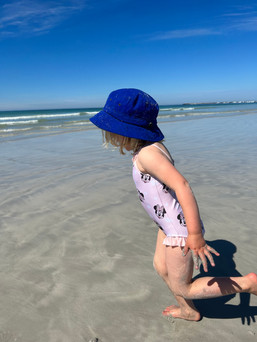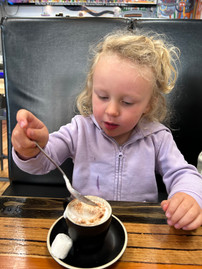Excursions and Outings
- Rachel Smith

- Mar 21, 2024
- 3 min read
Embarking on adventures beyond the walls of our service has become a cherished highlight of our weekly routine. Stepping out into the community is an experience we eagerly anticipate. These excursions are not merely about exploring. For the little explorers in my care, these outings are more than moments of joy and wonder—they're portals to boundless learning opportunities. As we delve into the real world beyond Rachel's Home Child Care, their eyes light up with curiosity as we drive past the cows being moved from paddock to paddock, or as we see the sheep get loaded into a truck. Beyond the walls of our service, there is a vibrant mosaic of experiences awaiting us. Engaging with nature's wonders, embracing diverse cultures, each adventure contains a wealth of knowledge that ignites the children's imaginations and extends their learning experiences beyond the standard learning to be expected from the 4 walls of a classroom.
Yet, it's not just the children who reap the rewards of these escapades. For me, as their guide and mentor, these outings serve as a rejuvenating tonic for the soul an escape from the 4 walls of my home which occasionally feel like they get closer and closer together! Witnessing their unbridled enthusiasm and insatiable curiosity rejuvenates my passion for teaching. Moreover, these experiences offer a chance to connect, learn, and share alongside the children, fostering bonds that resonate far beyond the excursion itself.
But the ripple effect extends even further. Our irrupt into the community don't just benefit us within the bounds of our service. They weave a vibrant thread within our community tapestry. Whether it's engaging with local businesses, connecting with other families, or simply spreading smiles and joy as we explore, our presence and interactions contribute to the collective spirit of our neighbourhood and our wider Limestone Coast Community, and even beyond this to be inspiring not just family day care educators but also centre based care educators and parents, grandparents and other carers alike.
So let's delve a little deeper and find more about Excursions and Outings!
What does ACEQA say about Excursions?
The Australian Children's Education & Care Quality Authority (ACECQA) acknowledges the importance of excursions as a valuable component of early childhood education. ACECQA does not provide specific guidelines exclusively dedicated to excursions, they emphasise the significance of excursions within the broader context of quality in early childhood education and care.
ACECQA incorporates the principles of excursions and outdoor activities within the National Quality Framework (NQF) and National Quality Standard (NQS). These frameworks highlight the need for early childhood services to offer a holistic and enriching environment that includes a range of experiences, including excursions, to promote children's learning and development.
Under the NQS, several standards relate to the planning and implementation of excursions:
Standard 3 (Physical Environment): Encourages services to provide a physical environment that is safe, suitable, and promotes exploration and learning, including outdoor experiences.
Standard 6 (Collaborative Partnerships with Families and Communities): Encourages services to engage families and the community, which may involve excursions to local places of interest or engagement with community members.
Standard 7 (Leadership and Service Management): Focuses on effective leadership and management, including risk assessment and safety procedures for excursions.
ACECQA emphasizes that excursions should be aligned with the service's educational program and support the learning outcomes outlined in the Early Years Learning Framework (EYLF). They encourage educators to plan and conduct excursions that are developmentally appropriate, safe, and enhance children's learning experiences.
While ACECQA doesn't provide a specific policy solely dedicated to excursions, they underscore the importance of excursions in contributing to a well-rounded educational experience for children, integrating them as part of the broader educational framework and ensuring their alignment with safety, learning and developmental objectives outlined in the NQF and NQS.
What Does the EYLF day about Excursions?
The Early Years Learning Framework (EYLF) in Australia acknowledges the significance of excursions as valuable learning experiences for young children. While the EYLF doesn't provide specific detailed guidelines focused on excursions, it highlights the importance of holistic learning that encompasses various experiences, including excursions, to support children's learning and development.
Excursions and their potential Challenges:
While excursions offer numerous benefits, there are some potential challenges or negative aspects that educators and childcare providers should consider:
Safety Concerns: Excursions involve leaving the familiar environment of the childcare setting, which can pose safety risks. These risks include transportation hazards, potential accidents in unfamiliar locations, or exposure to unpredictable situations (e.g., weather changes).
Logistical Challenges: Planning and organising excursions require careful coordination. It involves considerations such as transportation arrangements, ensuring appropriate adult-to-child ratios, obtaining permissions from parents, and managing potential disruptions to the routine.
Cost and Resources: Excursions often incur additional costs for transportation, entry fees to certain destinations, or special equipment. Not all services may have the resources to fund frequent or extensive outings.
Disruption to Routine: Excursions can disrupt the daily routine of the childcare setting, impacting scheduled activities or nap times. This disruption might affect some children more than others, leading to potential behavioral changes or challenges in managing their needs.
Limited Accessibility: Not all destinations or venues may be accessible to children with diverse needs or disabilities. Some locations might not be suitable or safe for all children, limiting the inclusivity of certain excursions.
Risk Management: Educators must be vigilant about risk management during excursions, such as monitoring children in unfamiliar environments, ensuring proper supervision, and responding promptly to any emergencies.
Weather-Related Challenges: Outdoor excursions are susceptible to weather changes, which can impact the experience and safety of the children. Unfavorable weather conditions might necessitate last-minute changes or cancellations.
Educator Workload: Planning, organising, and reflecting on excursions can add to the workload of educators. This includes preparation, documentation of experiences, and follow-up activities.
Parental Concerns: Some parents may express concerns about their child's safety or well-being during excursions, leading to anxiety or reluctance in granting permission for their child to participate.
Unpredictable Experiences: Unexpected situations, such as sudden closures of planned destinations or unforeseen events during the excursion, can affect the planned learning outcomes or experiences.
While these negative aspects exist, proactive planning, thorough risk assessment, clear communication with parents, and proper supervision can help mitigate these challenges, ensuring that excursions remain enriching and safe experiences for children in early childhood education.
Practical Application and Participation in Excursions with your family day care service
Implementing excursions effectively your family day care service involves careful planning, consideration of safety measures, alignment with learning outcomes, and engagement with the broader community. There are lots of different elements of varying degrees of importance to consider. By implementing some basic, yet practical steps, we can effectively plan, execute, and maximise the educational benefits of excursions, creating enriching experiences for children that complement their services based learning.
Some things to consider:
Identify Learning Objectives:
Begin by identifying specific learning outcomes or objectives aligned with the curriculum or educational framework (such as the EYLF).
Determine what skills, knowledge, or experiences you aim to offer children through the excursion.
Risk Assessment and Planning:
Conduct thorough risk assessments for the proposed excursion destinations or activities to ensure children's safety.
Plan logistics, including transportation, adult-to-child ratios, emergency procedures, and necessary permissions from parents/guardians.
Select Suitable Destinations or Activities:
Choose destinations or activities that align with learning objectives and are developmentally appropriate for the children's age group.
Consider various places like parks, libraries, museums, farms, community centers, or local businesses that offer educational experiences.
Prepare Children and Educators:
Introduce the excursion to children in advance, discussing the purpose, expectations, and safety rules.
Educators can prepare by planning engaging activities, discussions, or questions to enhance learning during the excursion.
Engage with the Community:
Foster relationships with local community members or organizations to enhance children's understanding and engagement during excursions.
Encourage interactions and discussions with community members to enrich the learning experience.
Reflection and Follow-Up:
After the excursion, engage children in reflection sessions to discuss their experiences, what they learned, and their favorite parts.
Use follow-up activities in the childcare setting to reinforce learning from the excursion, such as artwork, storytelling, or discussions.
Continuous Improvement:
Evaluate the success of the excursion, considering feedback from educators, children, and parents.
Use this feedback to continuously improve future excursions, addressing any safety concerns or enhancing learning experiences.
Incorporate Documentation:
Document children's experiences during the excursion through photos, videos, or journal entries to share with parents and reflect on learning outcomes.
Example Excursion:
This example demonstrates how an excursion plan to a local park with a Family Day Care service aligns with safety measures, learning objectives, parental engagement, and child-centered activities to ensure an enriching and safe learning experience.
Excursion Destination: Local Park
Learning Objectives:
Encourage physical activity and gross motor skill development through play.
Foster social skills by interacting with peers in a natural setting.
Promote appreciation for nature and the environment.
Practice safety rules and awareness in an outdoor environment.
Preparation and Planning:
Date and Time: Thursday, January 20, 10:00 AM - 12:00 PM.
Safety Measures: Adult-to-child ratio of 1:4, with three caregivers attending.
Transportation: Walking to the park, approximately 10 minutes from the Family Day Care home. Review road safety rules before departure.
Permissions: Obtain parental consent for each child's participation, including emergency contact details.
Equipment: Pack sunscreen, hats, water bottles, and a small first aid kit.
Parent Engagement:
Share details with parents regarding the excursion's purpose, learning objectives, safety measures, and what children may expect.
Child Engagement Pre-Excursion:
Discuss the park visit with children, mentioning the activities they might engage in (e.g., playing on swings, nature walks, picnicking).
Encourage them to bring their favorite outdoor toy or book to share with friends.
During the Excursion:
Upon arrival, conduct a safety briefing reminding children about park rules (e.g., staying within sight, not running near swings).
Engage children in various activities such as playing on swings, exploring nature trails, observing wildlife, and enjoying a picnic snack.
Encourage cooperative play and social interactions among children.
Educators actively supervise and guide children, ensuring safety and maximizing learning opportunities.
Post-Excursion:
Gather children for a reflection session. Discuss their favorite activities, discoveries made, and any new things they learned at the park.
Document the excursion through photos or drawings created by the children.
Share a brief summary and photos with parents to involve them in their child's experience.
Specific links to the EYLF and NQS
Encourage physical activity and gross motor skill development through play:
EYLF Link: The EYLF emphasizes physical development through Outcome 3: Children have a strong sense of wellbeing. This outcome encourages children to become increasingly competent and confident in their gross motor skills through active play.
NQS Link: The National Quality Standard focuses on providing opportunities for children to engage in physical activities in Quality Area 3: Physical Environment. Standard 3.2 specifically addresses promoting physical activity.
Foster social skills by interacting with peers in a natural setting:
EYLF Link: Social development is a key aspect outlined in the EYLF's Outcome 2: Children are connected with and contribute to their world. It emphasizes children's abilities to interact positively with others and form relationships.
NQS Link: Quality Area 5: Relationships with Children in the National Quality Standard encompasses standards related to fostering positive interactions between children in various settings.
Promote appreciation for nature and the environment:
EYLF Link: Appreciation for nature aligns with Outcome 2 of the EYLF, emphasizing children's respect and understanding of the natural environment and its significance to their lives.
NQS Link: Quality Area 3: Physical Environment, in the National Quality Standard, highlights the importance of providing environments that promote respect for the environment and sustainable practices.
Practice safety rules and awareness in an outdoor environment:
EYLF Link: Learning about safety and risk awareness falls within Outcome 3 of the EYLF, emphasizing children's ability to assess risks and engage in safe practices.
NQS Link: Quality Area 2: Health and Safety addresses standards related to promoting children's health and safety, including learning about safety rules in outdoor environments.
Excursion Benefits for us as educators:
Going on excursions as part of their educational routine can significantly contribute to the mental health and well-being of educators in several ways:
Change of Environment: Excursions offer a break from the daily routine within the Family Day Care setting. This change of scenery and environment can be refreshing for educators, reducing stress and monotony.
Enhanced Motivation: Engaging in outdoor excursions often brings joy and excitement for both educators and children. Witnessing children's curiosity and enthusiasm during these outings can reignite passion and motivation in educators for their profession.
Reduced Stress: Being in natural settings or different environments can have a calming effect on mental health. The exposure to nature during excursions can help alleviate stress and promote relaxation for educators.
Personal Enjoyment: Educators may find personal enjoyment and satisfaction in exploring new places, learning alongside children, and sharing experiences. This sense of fulfillment can positively impact their mental health.
Social Interaction: Excursions often involve interactions with other educators, parents, or community members. These social interactions provide opportunities for networking, support, and sharing experiences, fostering a sense of community among educators.
Professional Development: Excursions offer learning opportunities for educators too. They can discover new teaching methods, observe child behavior in different environments, and gain insights into children's interests and preferences, contributing to their professional growth.
Physical Activity: Participating in outdoor excursions usually involves physical activities, such as walking, exploring, or engaging in play with children. Physical exercise is known to positively impact mental health by releasing endorphins and reducing stress.
Sense of Achievement: Successful planning and execution of excursions can instill a sense of accomplishment and pride in educators. Seeing children learn and engage in real-world experiences can be immensely rewarding.
Renewed Creativity: Exposure to different environments and experiences during excursions can spark creativity in educators, allowing them to develop innovative teaching methods or activities for children.
Overall, excursions provide educators with a break from the routine, opportunities for personal and professional development, and the chance to witness children's growth and development in diverse settings. This can lead to improved mental well-being and job satisfaction for educators within the childcare setting.
Frequently Asked Questions:
Everyone Loves a FAQ section: (have something to ask, ask in the comments)
Why are excursions important in early childhood education?
Excursions offer real-world experiences that enhance children's learning, promote social skills, stimulate curiosity, and foster connections with the community. They provide opportunities for hands-on learning beyond the classroom.
How do excursions contribute to children's learning and development?
Excursions promote various aspects of development, including cognitive, social, emotional, and physical skills. They encourage exploration, critical thinking, problem-solving, and support the development of independence and resilience.
What safety measures are in place during excursions?
Safety measures include risk assessments, appropriate adult-to-child ratios, first aid training for educators, transportation safety protocols, emergency procedures, and parental consent for participation.
What types of places can children visit during excursions?
Children can visit a range of places, such as parks, museums, libraries, zoos, botanical gardens, community centers, farms, local businesses, and natural settings, depending on educational goals and safety considerations.
How can parents be involved in excursions?
Parents can participate by offering consent for their child's participation, volunteering as chaperones, contributing ideas for excursion destinations, or sharing expertise related to the excursion theme.
How often do childcare services conduct excursions?
The frequency of excursions varies among childcare services. Some conduct excursions weekly, bi-weekly, or as monthly outings, depending on factors such as resources, educational goals, and parental involvement.
What should children bring for an excursion?
Children may need essentials such as water bottles, hats, sunscreen, weather-appropriate clothing, comfortable shoes, and any specific items relevant to the excursion destination or activity.
How are excursions planned and communicated to parents?
Educators plan excursions based on learning objectives, conduct risk assessments, arrange logistics, and communicate details to parents through permission forms, information sheets, emails, or parent meetings.
What happens if the weather is unfavorable on the day of the excursion?
Educators might consider rescheduling the excursion, modifying activities for indoor venues, or having alternative plans in place to ensure children's safety and an engaging learning experience.
How do educators ensure learning continues after an excursion?
Post-excursion activities, discussions, reflections, and documentation help reinforce learning from the excursion. Educators integrate experiences into the curriculum to extend learning back in the childcare setting.
Throughout this post, we've delved into the multifaceted realm of early childhood education, particularly focusing on the significance of excursions in nurturing young minds. Excursions, while undeniably valuable for broadening children's horizons, fostering social connections, and offering real-world learning experiences, are not the sole avenue for enrichment. Our exploration has highlighted the adaptability of education, especially when caring for younger children, where the home environment serves as a hub for tailored, age-appropriate activities.
We've navigated the intricacies of balancing the educational needs of a diverse group, acknowledging that while outings can be enriching, the nurturing home environment can equally stimulate growth and development. From structured indoor activities to nature-inspired engagements, the emphasis remains on fostering curiosity, inclusivity, and age-appropriate learning. The integration of online resources as supplements to home-based activities showcases the versatility and adaptability in creating meaningful learning experiences.
The core principle underpinning this post underscores the importance of holistic development, whether within the confines of home or through enriching excursions. Flexibility, thoughtful planning, and a focus on tailoring activities to suit the developmental stages of each child emerge as pillars in nurturing their curiosity, growth, and overall well-being within the context of early childhood education. Ultimately, whether exploring the world beyond or engaging within the comforts of home, the goal remains consistent: to provide a stimulating and nurturing environment that lays the foundation for a lifelong love of learning and growth.































Comments